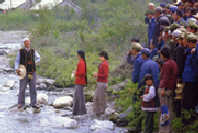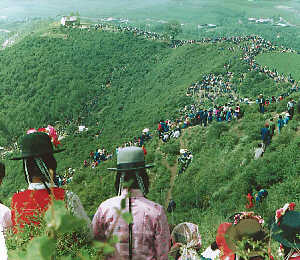
Taomin Hua'er is a general term including Lotus Mountain Hua'er and Min County Hua'er. It is popular mainly among the Han people and prevails in Linxia Hui Autonomous Prefecture's Kangle and Hezheng counties, Dingxi Region's Lintao and Weiyuan counties, Wudu Region's Minxian, Wudu, Dangchang and Wenxian counties and Lintan, Zhuoni and Zhouqu counties of Gannan Tibet Autonomous Prefecture ofGansu Province.
Taomin Hua'er could be further categorized as Southern and Northern Hua'er mainly in terms of the differences in tunes, lyrics and performing styles. The Southern Hua'er is mainly centered on theErlang MountainHua'er in Minxian County, and the Northern Hua'er is based on the Lianhua Mountain Hua'er in Kangle County.
 Taboos of Hua'er
Taboos of Hua'er
 Because of the fervent and impassioned content of Hua'er lyrics, there used to be three taboos of performing the art form. First, Hua'er could not be sung in the village, let alone in the family. Second, Hua'er could not be performed between some relatives, especially the relatives of different gender and of different generations, such as parents and children, and an uncle and niece or nephew. Third, Hua'er could not be performed in public places like schools and government organizations. From these taboos, we can understand the grassroots nature of Hua'er.
Because of the fervent and impassioned content of Hua'er lyrics, there used to be three taboos of performing the art form. First, Hua'er could not be sung in the village, let alone in the family. Second, Hua'er could not be performed between some relatives, especially the relatives of different gender and of different generations, such as parents and children, and an uncle and niece or nephew. Third, Hua'er could not be performed in public places like schools and government organizations. From these taboos, we can understand the grassroots nature of Hua'er.
In the past, the ruling "orthodox" class did not allow people to sing Hua'er and thought of various means to harass its development. Nevertheless, Hua'er demonstrated its vitality despite the harsh condition. By singing Hua'er, people bravely cried out their hope to breach the feudal ethical codes as well to express their pursuit for freedom and love.
Hua'er brought confidence and courage for the hardworking people living on the desolate land. The efforts to kill the art form by the ruling class in feudal society went in vain, and quite on the contrary, the art thrived and spread even wider with greater popularity. As a matter of fact, the Hua'er creators and singers in the past were mostly laborers living at the bottom of the society like the ferrymen of theleather rafts. This oral folk art form reflected their true life and inner world, adding to its appeal.
Author: Jeff
